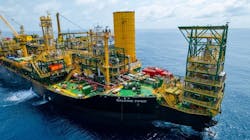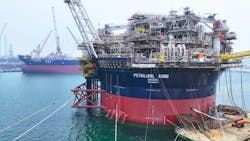North Sea offers options for reuse of platforms from decommissioned fields
Jeremy Beckman * Editor-Europe
Operators are scouting the second-hand FPSO market as they look to speed up the timelines of their greenfield developments, both in West Africa and the North Sea. And some fixed platforms in the North Sea area are under review for new roles in carbon capture and storage, which would allow heavy decommissioning costs to be deferred.
Eni, in partnership with PetroCi, has been developing the Baleine field offshore Côte d'Ivoire on a fast-track basis. Baleine, extending across deepwater blocks CI-101 and CI-802, is the country’s largest oil and gas discovery to date, with an estimated 2.5 Bbl in place and 3.3 tcf of associated gas. For the first-phase development, which went onstream in August 2023, Saipem performed life extension/upgrade works on the FPSO Firenze (now the Baleine) which had previously operated on Eni’s Aquila field in the Adriatic Sea offshore Italy. The program included fabrication and integration of the new topsides, turret and mooring system to support peak production of up to 15,000 b/d of oil and 17.5 MMcf/d of gas.
For Baleine Phase 2, Eni commissioned Altera Infrastructure (formerly Teekay Partners) to convert and upgrade the 70-m (229-ft) diameter, circular FPSO Voyageur Spirit, which had produced oil from the Huntington field in the central UK North Sea until 2020. For additional storage capacity/export purposes, the contract included conversion of the Altera shuttle tanker Nordic Brasilia. Both programs took place in parallel at Drydocks World, Dubai under another fast-track execution model.
According to Altera, the 14-month conversion of the FPSO (since renamed Petrojarl Kong) entailed extensive production engineering and major demolitions to accommodate installation of new modules, along with substantial structural steelwork and coating. Conversion of the shuttle tanker to the FSO Yamoussoukro was an 11-month exercise involving detailed engineering, structural refurbishment, life extension works, and conversion/coating work of all the cargo and ballast tanks. Eni was aiming to start-up Phase 2 this December, with Altera as owner and operating of the two vessels under a 15-year contract. Both will be stationed 50 km offshore alongside the Phase 1 FPSO Baleine, lifting production from the field to 60,000 b/d of oil and 70 MMcf/d of associated gas.
Another upgrade project at Drydocks World concerns the ship-shaped FPSO Knarr, which formerly operated on the Knarr field for Shell offshore Norway. Equinor and its partners plan to re-deploy the vessel for their deepwater Rosebank oil and gas development, 130 km west of Shetland in far-northern UK waters. Altera appointed Aker Solutions to manage the detail design, followed by the physical upgrade work under a joint venture with Drydocks World. The EPC contract scope, which is due to be completed by the end of next year, covers newbuild, demolition and life extension works to the hull, marine systems and topsides so that the FPSO can remain at Rosebank for 25 years without the need for drydocking.
However, political developments in the UK are complicating matters. Rosebank’s first-phase development has an estimated budget of $3.8 billion. To limit its share of the costs, Equinor had started a sale process for a 20% stake in the development, but during the summer decided to suspend its offer due to general anxiety in the industry over the direction of taxation of UK offshore petroleum activities. The new Labour government has pledged to raise the Energy Profits Levy that the previous Conservative administration imposed on the sector, and to withdraw various offsetting allowances. These measures will be introduced in the UK Chancellor’s Budget at the end of this month – North Sea E&P companies are waiting to see if there will be any further clarity on the longer-term outlook, as they continue to press the case for fiscal stability so that they can sustain investments in the UK.
Another spanner in the works was the new government’s decision not to contest judicial reviews brought against the development consents for Rosebank and Shell’s Jackdaw gas project in the central UK North Sea – despite the fact that both have regulatory approvals. Following the `Finch’ ruling, regulators must now consider the impact of hydrocarbon combustion, Scope 3 emissions, in their Environmental Impact Assessment for proposed new projects. The UK’s Offshore Petroleum Regulator for Environment & Decommissioning (OPRED) responded that it would defer assessment of environmental statements for other planned offshore projects until new guidance is in place, with the government not expecting the consultation process to finish until next spring.
NEO Energy and its partners in the Buchan Horst license in the UK central North Sea are also looking to re-deploy an FPSO for their redevelopment of the Buchan oilfield and surrounding area. An agreement is in place to use the circular Western Isles floater that produced oil from the Barra and Harris fields in the East Shetland basin until operations ceased permanently in May. Dana Petroleum is the operator, in partnership with NEO.
But in light of the Finch ruling and the uncertain fiscal framework, the company and its owner HitecVision have agreed to slow down work on all NEO’s UK North Sea area development interests. NEO added that the timing of first oil from the seven-well, 70-MMboe Buchan Horst project would be pushed back beyond the previously targeted start-up in late 2027. In the meantime, the company and co-venturers Jersey Oil & Gas and Serica Energy are pursuing a license extension in order to assess the impact of the changes to tax and environmental consents.
Another reuse project that appears to have gone quiet is Avalon in the Outer Moray Firth in the North Sea. Kuala Lumpur-based Ping Petroleum planned to develop the 2014 oil discovery Avalon with the circular FPSO Excalibur (ex-Hummingbird Spirit), which formerly operated on Spirit Energy’s Chestnut field. Partner Cerulean Winds will provide an offshore wind turbine to power the platform. OPRED, however, raised 42 points of inquiry concerning Ping Petroleum’s Environmental Statement (ES). For instance, it asked Ping for clarity on how power generation on the FPSO would be impacted if the proposed import/export power cable or the wind turbine did not proceed, with further questions concerning flaring related to the installation of a potential gas import/export line.
Commenting on these developments, James Reid, Senior Research Analyst, North Sea Upstream at Wood Mackenzie, said: “Rosebank is a capital heavy project in a harsh environment (West of Shetland). Bringing a third partner to join it and Ithaca (20%) will help de-risk the project from a commercial perspective. However, the fiscal instability in the UK over the last 12 months has impacted the M&A market. We’ve seen the lowest level of M&A activity (both in terms of deals done and value traded) in over a decade. We assume investors will be waiting to see what changes are made to the fiscal system, especially with the capital allowances, prior to making any M&A or large investment decisions.
“Rosebank’s economics are robust, even under a scenario with reduced capital allowances, so we expect this will go ahead as planned. The project has significant capital already committed with orders placed for long-lead items and the topside modifications of the FPSO already in progress Subsea installations have been ongoing over the summer and drilling is expected to commence in Q1 2025.
“The Buchan re-development is slightly further back in terms of maturity of the development. The project is yet to receive approval from the regulatory bodies. The Buchan field stopped producing in 2017 due to asset integrity issues with the previous installation. From a reservoir performance and technical standpoint, the project is less risky. It’s the above-ground risk that presents the challenge for the partners at Buchan. Assuming the government honors its pledge to remove the Energy Profits Levy in its current form, in 2030 (and there’s a very big risk it won’t do that) there is a chance we could see projects like Buchan delayed.”
Other owners of North Sea platforms on fields that are either shut down permanently or in the late-life phase are considering reuse in Carbon Capture and Utilization (CCUS) scenarios. According to Catherine Horseman-Wilson, Principal Analyst, CCUS Research at Wood Mackenzie: “The UK is one of the leading countries developing CCUS where reuse of infrastructure is being considered in new carbon storage projects. Other examples include the Netherlands, where the Porthos project plans to reuse a North Sea gas platform and Eni’s Ravenna CCS project in central Italy.” Here Eni has recently started transporting carbon from an onshore natural gas treatment plant through converted pipelines to the Porto Corsini Mare Ovest platform in the Adriatic Sea, where the carbon is injected into the field of the same name for storage at a depth of 3,000 m (9,842 ft). “The reuse of existing facilities is attractive to developers, Horseman-Wilson added, “as it represents an opportunity to reduce project capex as well as the deferral of decommissioning liabilities.
“The UK’s North Sea Transition Authority has built firm requirements into license awards where the reuse of offshore kit is intended, in order to confirm suitability for use with CO2. For example, the CO2 license located in the northern North Sea, where there is a proposal to reuse bp’s Miller gas pipeline for CO2 transport, has a work program which requires a series of studies and reviews, alongside an in-line inspection to ensure the suitability of the pipeline. The Hynet North West CCUS project onshore/offshore North-west England and North Wales has seen detailed concept and assessment work carried out in order to make decisions relating to the potential reuse of the Eni-operated Liverpool Bay platforms. The reuse of existing production wells on the Hamilton and Lennox fields calls for sidetracks to be drilled within the existing template and the installation of CO2 resistant tubulars and cement to make the wells suitable as future CO2 injectors.
“Beyond these limited illustrations in the North Sea sector, we don't currently see repurposing facilities as a big theme globally. But the sector is growing and this could change, with projects in South-east Asia for example, beginning feasibility studies to look into these options.”
About the Author
Jeremy Beckman
Editor, Europe
Jeremy Beckman has been Editor Europe, Offshore since 1992. Prior to joining Offshore he was a freelance journalist for eight years, working for a variety of electronics, computing and scientific journals in the UK. He regularly writes news columns on trends and events both in the NW Europe offshore region and globally. He also writes features on developments and technology in exploration and production.


